How To Create A Script In Windows 10

On Windows 10, PowerShell is a tool designed to run commands and scripts to change settings, automate tasks, and other actions. In a way, information technology's similar to Command Prompt. Withal, PowerShell is a more than capable command-line interface (CLI) that offers a more extensive gear up of tools and more flexibility and control. Also, unlike Command Prompt, PowerShell is bachelor across platforms, including Windows, macOS, and Linux.
A script is a collection of instructions saved into a text file (using the special ".ps1" extension) that PowerShell understands and executes in sequence to perform different actions.
The merely caveat is that the default security protocol always blocks scripts from running on your computer. This means that when double-clicking a ".ps1" file on Windows x, aught volition happen, and if you try to run the script within PowerShell, you'll encounter the "cannot be loaded because running scripts is disabled on this system" error bulletin. Nevertheless, running scripts on a laptop or desktop reckoner is not impossible. You lot merely need to enable the correct execution policy.
In this Windows 10 guide, we will walk you through the steps to successfully write and run your offset script file on PowerShell using Visual Studio Lawmaking, Notepad, and the PowerShell Integrated Scripting Environment (ISE) panel.
- How to create PowerShell script file on Windows 10
- How to run PowerShell script file on Windows 10
How to create PowerShell script file on Windows 10
You can create PowerShell script files using well-nigh whatsoever text editor or the legacy ISE panel. However, the preferred option (thank you, @JotaKa, for the tip) to write scripts is using the Visual Studio Code editor with the PowerShell extension.
Create script with Visual Studio Lawmaking
Visual Studio Code (VS Lawmaking) is a complimentary and extensible cross-platform lawmaking editor that allows you to edit virtually any programming language. And when calculation the PowerShell extension, you get an interactive scripting editing experience, even with IntelliSense (code-completion) support.
The PowerShell ISE application will continue to exist available, but the Visual Studio Code with the PowerShell extension is meant to be the new default experience. Also, consider that the legacy feel won't get whatever new features and doesn't back up PowerShell seven or higher releases.
Install Visual Studio Lawmaking
To install Visual Basic Lawmaking on Windows 10, use these steps:
- Open Visual Studio Download page.
- Click the Windows push button to download the installer.

- Double-click the installer to begin the installation process.
- Ostend the agreement terms.
- Click the Side by side button.
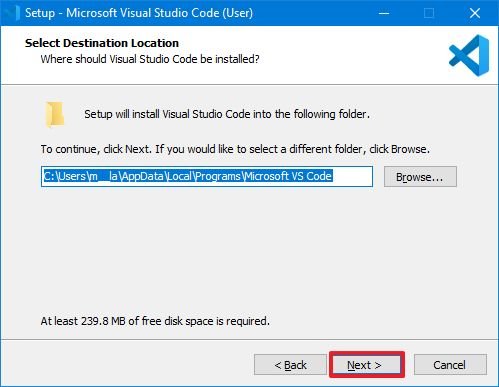
- Click the Next button again.
- Click the Next button one more time.
- Confirm boosted tasks as necessary.
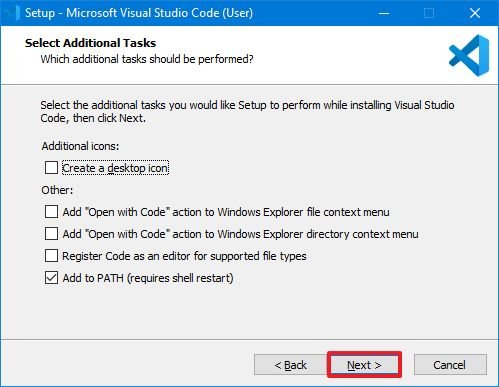
- Click the Next button.
- Click the Install button.
- Click the Stop button.
One time yous consummate the steps, yous can continue installing the PowerShell extension.
Install PowerShell extension
To install the PowerShell extension on VS Code, use these steps:
- Open up VS Code.
- Click the Extensions tab (Ctrl + Shift + X) from the left pane.
- Search for PowerShell and select the top result.
- Click the Install push.
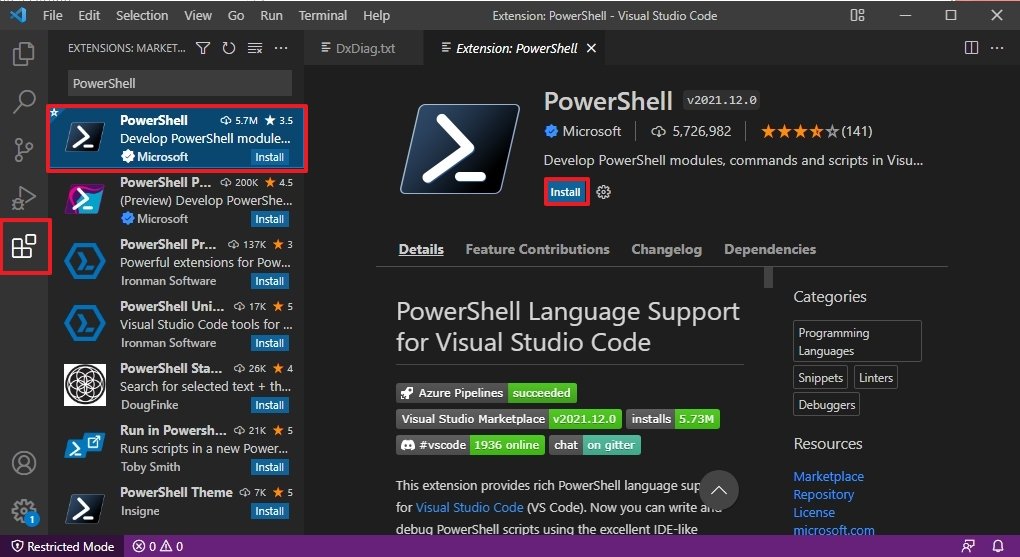
- Click the Trust Workspace & Install button.
Later on yous complete the steps, you can outset writing PowerShell scripts using Visual Studio Code on Windows 10.
Create PowerShell script with Visual Studio Code
To create a script with Visual Basic Lawmaking, use these steps:
- Open VS Code.
- Click the File menu and select the New File option.
- Click the File card and select the Save As option.
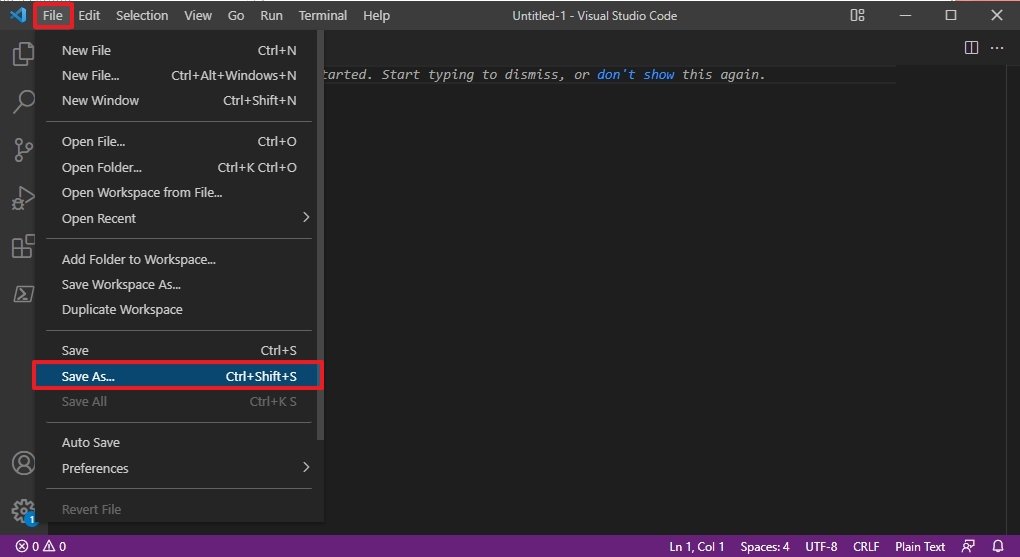
- In the "File name" field specify a name for the file with the .ps1 extension — for case: first_script.ps1.
- Click the Salve push button.
- Write a new or paste the script you want to run — for example:
Write-Host "Congratulations! Your showtime script executed successfully"Quick note: The higher up script will output the phrase "Congratulations! Your outset script executed successfully" on the screen. - (Optional) Click the Run button from the top-right side (or press the F5 key) to run the script.
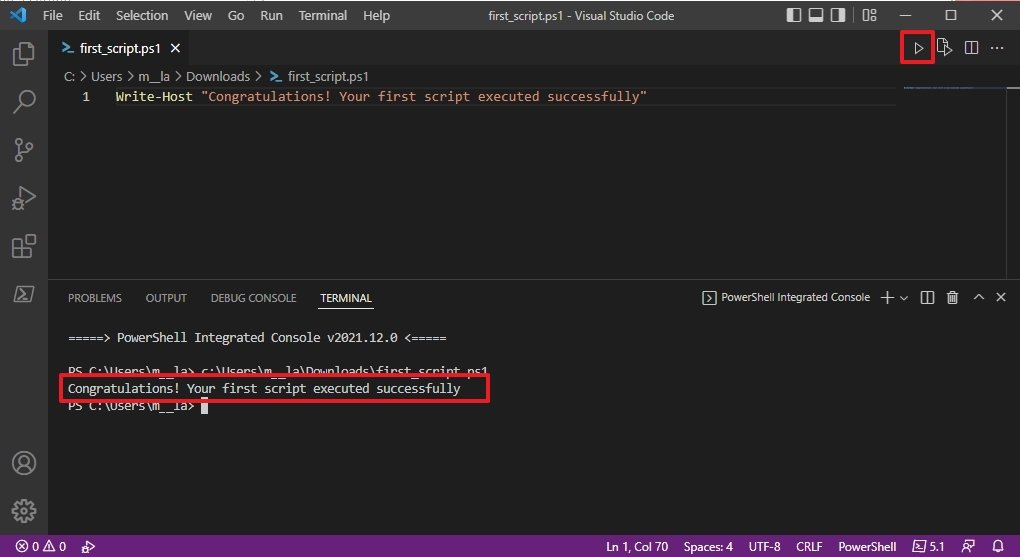
- Click the File menu.
- Click the Save option.
Create PowerShell script with Notepad
To create a PowerShell script using the Notepad editor on Windows 10, use these steps:
- Open Start.
- Search for Notepad, and click the summit result to open up the app.
- Write a new or paste your script in the text file — for example:
Write-Host "Congratulations! Your starting time script executed successfully"

- Click the File bill of fare.
- Select the Salvage Equally choice.
- Ostend a descriptive name for the script — for example, first_script.ps1.

- Click the Save button.
Create PowerShell script with Integrated Scripting Environment
Alternatively, you can use the built-in PowerShell ISE console to code your scripts on Windows 10.
The Integrated Scripting Environment is an avant-garde tool, but you can get started using these steps:
- Open First.
- Search for Windows PowerShell ISE, right-click the meridian consequence, and select the Run as ambassador pick.
- Click the File menu.
- Select the New option to create a new empty .ps1 file.
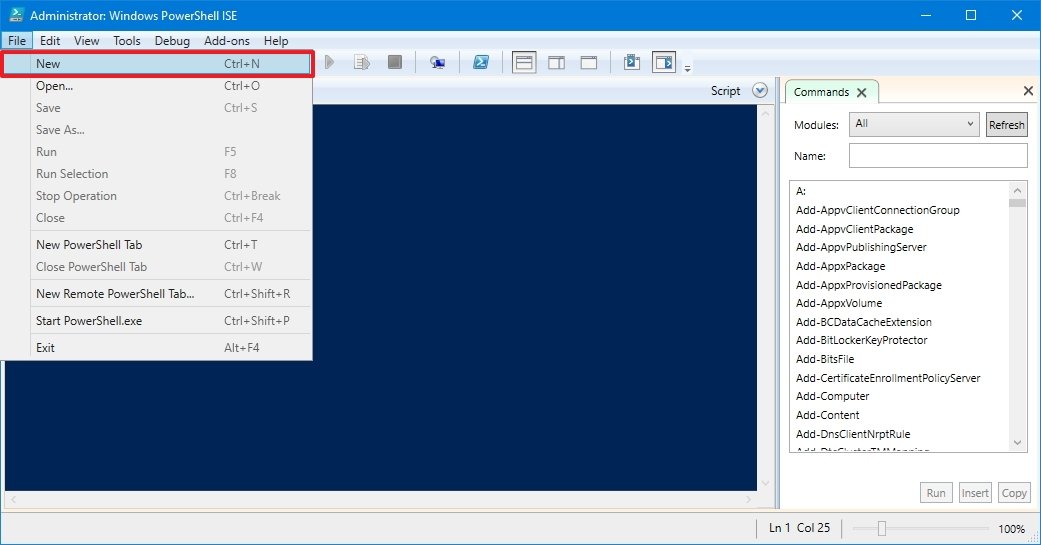
- Write a new, or paste the script you desire to run — for example:
Write-Host "Congratulations! Your offset script executed successfully"
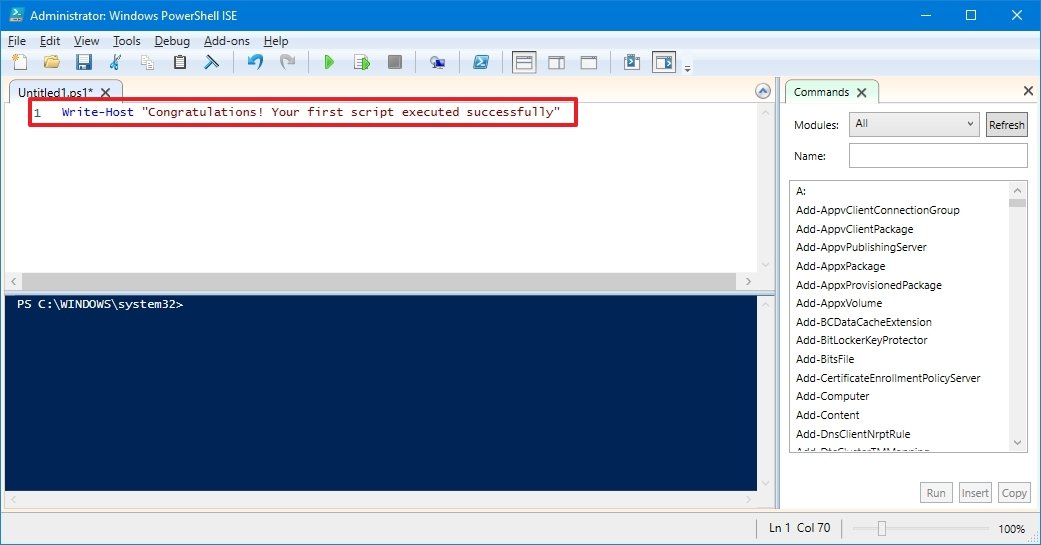
- Click the File menu.
- Click the Save selection.
- Type a proper noun for the script — for case, first_script.ps1.
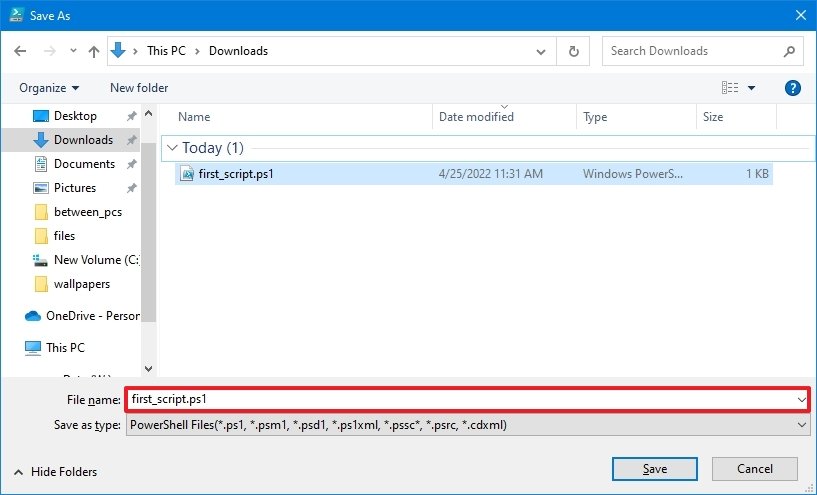
- Select the binder location to store the script file.
- Click the Save button.
- (Optional) Click the Run button from the top-right side (or press the F5 key) to run the script.
Once you lot complete the steps using Notepad, Visual Studio Code, or PowerShell ISE, the script will be set up to run, but information technology will neglect using the default system settings. The reason is that the default PowerShell settings are configured to block the execution of whatsoever script. (The only exception is if you run the script'south contents within Visual Studio Code or PowerShell ISE.)
How to run PowerShell script file on Windows 10
On Windows 10, to run a script file with the PowerShell console, you have to modify the execution policy.
To modify the execution policy to run PowerShell scripts on Windows ten, use these steps:
- Open Starting time.
- Search for PowerShell, right-click the height effect, and select the Run as administrator option.
- Blazon the post-obit control to permit scripts to run and press Enter:
Set-ExecutionPolicy RemoteSigned - Type A and press Enter (if applicable).
- Type the following command to run the script and press Enter:
& "C:\PATH\TO\SCRIPT\first_script.ps1"In the to a higher place command, modify "PATH\TO\SCRIPT" to the location of your script.For instance, this command runs a script stored in the Downloads folder:& "C:\Users\username\Downloads\first_script.ps1"
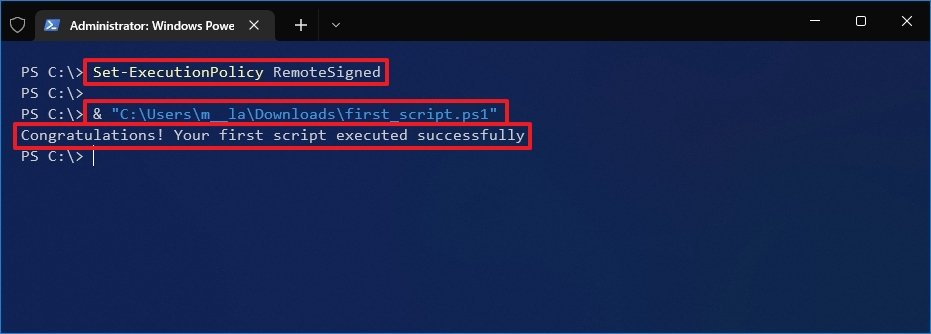
Later on you complete the steps, the script will run, and if it was written correctly, you should encounter its output on the screen without issues.
On Windows x, PowerShell includes iv execution policies:
- Restricted — Stops whatsoever script from running.
- RemoteSigned — Allows scripts created on the device, but scripts created on another estimator won't run unless they include a trusted publisher's signature.
- AllSigned — All the scripts will run, merely only if a trusted publisher has signed them.
- Unrestricted — Runs any script without any restrictions.
Y'all should only allow local scripts when you need to run a script from a trusted source. If you don't plan to run scripts regularly, it's a good idea to restore the default settings to cake untrusted scripts using the aforementioned instructions outlined above, only on step four, use the
Set-ExecutionPolicy Restricted command.
More Windows resources
For more helpful manufactures, coverage, and answers to mutual questions about Windows 10 and Windows eleven, visit the following resource:
- Windows 11 on Windows Central — All you need to know
- Windows xi assistance, tips, and tricks
- Windows 10 on Windows Central — All y'all demand to know
Mauro Huculak is technical author for WindowsCentral.com. His master focus is to write comprehensive how-tos to assist users become the virtually out of Windows 10 and its many related technologies. He has an IT background with professional certifications from Microsoft, Cisco, and CompTIA, and he'due south a recognized fellow member of the Microsoft MVP community.
Source: https://www.windowscentral.com/how-create-and-run-your-first-powershell-script-file-windows-10
Posted by: titusshence1962.blogspot.com

0 Response to "How To Create A Script In Windows 10"
Post a Comment